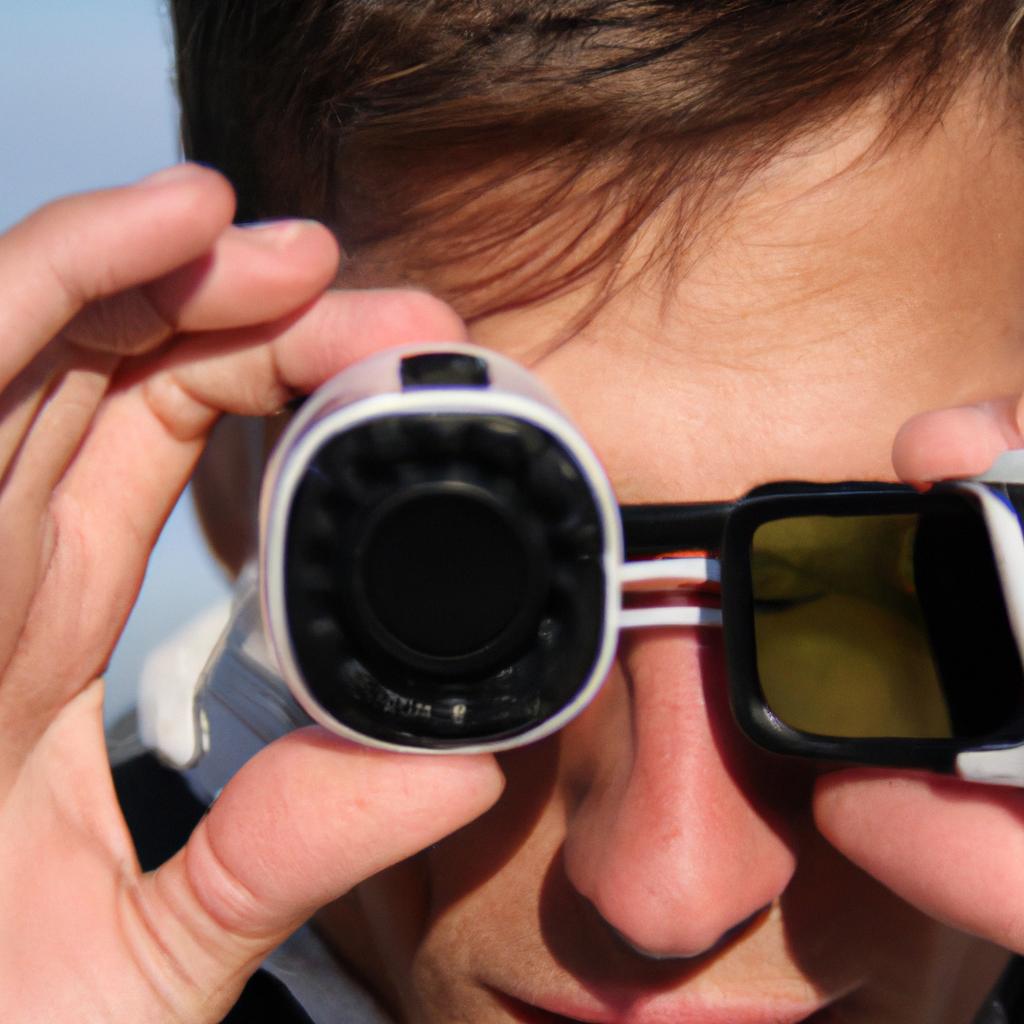Scratch Resistance in Sunglasses: Polarized Lenses

Scratch resistance is a crucial aspect to consider when selecting sunglasses, as it directly impacts the durability and longevity of the eyewear. Amongst various options available in the market, polarized lenses are widely acclaimed for their enhanced scratch-resistant properties. For instance, let us consider a hypothetical scenario where an individual named Sarah frequently engages in outdoor activities such as hiking and cycling. As she ventures into rugged terrains and encounters unpredictable weather conditions, her sunglasses endure constant exposure to potential scratches from branches, dust particles, and other environmental elements. In this article, we will delve into the concept of scratch resistance in sunglasses with a specific focus on polarized lenses.
When exploring the realm of scratch resistance in sunglasses, understanding the role of polarized lenses becomes paramount. Polarization refers to a specialized coating that reduces glare caused by reflections off surfaces such as water or glass. This technology not only enhances visual comfort but also provides protection against harmful UV rays emitted by the sun. Moreover, polarized lenses possess inherent scratch-resistant properties due to their construction process and unique materials used. These lenses consist of multiple layers, including a hard protective coating that safeguards against minor abrasions encountered during daily use or accidental mishaps.
Examining the benefits of scratch resistance in polarized lenses allows individuals to enjoy clear and unobstructed vision for a longer duration. The scratch-resistant properties of polarized lenses ensure that the eyewear remains in optimal condition even after frequent use or exposure to harsh environments. This durability factor makes them an ideal choice for outdoor enthusiasts like Sarah, who require sunglasses that can withstand the rigors of their activities.
In addition to providing protection against scratches, polarized lenses also offer other advantages. By reducing glare, they enhance visual clarity and contrast, allowing individuals to see more clearly in bright conditions. This is especially beneficial when engaging in activities such as water sports or driving, where glare can be particularly distracting and potentially dangerous.
To further enhance scratch resistance and overall longevity, it is important to properly care for polarized sunglasses. This includes storing them in a protective case when not in use, cleaning them with a microfiber cloth or lens cleaning solution specifically designed for sunglasses, and avoiding contact with abrasive surfaces or materials.
In conclusion, scratch resistance is a crucial consideration when selecting sunglasses, especially for individuals engaged in outdoor activities. Polarized lenses are highly recommended due to their enhanced scratch-resistant properties, which ensure long-lasting durability. By investing in high-quality polarized sunglasses with superior scratch resistance, individuals like Sarah can protect their eyes while enjoying optimal vision in various environmental conditions.
Importance of scratch resistance in sunglasses
Importance of Scratch Resistance in Sunglasses
Imagine purchasing a brand new pair of sunglasses, only to find that within a few weeks, the lenses are covered in unsightly scratches. This frustrating scenario is all too common and highlights the significance of scratch resistance in sunglasses. In this section, we will explore why scratch resistance is crucial for ensuring long-lasting durability and maintaining clear vision.
Scratches on sunglass lenses can compromise their functionality by obstructing vision and causing discomfort to the wearer. Consider a hypothetical case study where an individual spends a day at the beach wearing non-scratch-resistant sunglasses. As they engage in various outdoor activities such as playing volleyball or simply lounging under the sun, tiny particles of sand become trapped between their lens and other surfaces. Despite being careful, these unavoidable encounters result in numerous fine scratches across the lens surface. Consequently, when attempting to enjoy scenic views or read small text, distorted images and reduced clarity could hinder their experience.
To emphasize the importance of scratch resistance further, let us delve into some key points:
- Enhanced Longevity: Scratch-resistant coatings significantly extend the lifespan of sunglasses by protecting against minor abrasions caused by daily wear and tear.
- Improved Aesthetics: Scratched lenses not only impair visibility but also diminish the overall appearance of sunglasses. By investing in scratch-resistant eyewear, individuals can maintain a polished look without compromising style.
- Cost Savings: Purchasing scratch-resistant sunglasses may require a slightly higher initial investment; however, it proves cost-effective in the long run since these durable lenses reduce the need for frequent replacements.
- Preservation of UV Protection: Scratches weaken sunglass lenses’ ability to block harmful ultraviolet (UV) rays from reaching our eyes. Maintaining scratch-free lenses ensures optimal protection against potential eye damage caused by prolonged exposure to sunlight.
To illustrate these benefits visually, refer to Table 1 below:
Table 1: Benefits of Scratch-Resistant Sunglasses
| Benefits | Description |
|---|---|
| Enhanced Longevity | Protection against minor abrasions caused by daily wear and tear |
| Improved Aesthetics | Maintaining a polished look without compromising style |
| Cost Savings | Reduced need for frequent replacements, resulting in long-term savings |
| Preservation of UV Protection | Optimal protection against potential eye damage from UV rays |
In conclusion, scratch resistance plays a vital role in the performance and durability of sunglasses. By investing in scratch-resistant lenses, individuals can ensure clear vision, prolong the lifespan of their eyewear, enhance aesthetics, save on replacement costs, and preserve optimal protection against harmful UV radiation.
Moving forward to Factors that affect scratch resistance…
Factors that affect scratch resistance
Scratch Resistance in Sunglasses: Polarized Lenses
Importance of scratch resistance in sunglasses:
Ensuring that sunglasses have a high level of scratch resistance is crucial for maintaining their longevity and functionality. Imagine investing in a new pair of sunglasses, only to find scratches on the lenses after just a few uses. This not only compromises the aesthetic appeal but also hampers the clarity of vision. To understand why scratch resistance matters, let us consider the following example.
Case Study: Sarah purchased a pair of sunglasses with non-scratch resistant lenses for her upcoming beach vacation. She packed them carefully, ensuring they were protected from any potential damage during travel. However, upon reaching her destination and taking them out to wear, she noticed several fine scratches on the lenses. These scratches affected her ability to see clearly under bright sunlight and caused frustration throughout her trip.
Factors that affect scratch resistance:
Several factors influence the scratch resistance of sunglasses’ lenses. Understanding these factors can help consumers make informed decisions when purchasing eyewear. Here are some key considerations regarding scratch resistance:
- Lens material: Different lens materials vary in their susceptibility to scratching. For instance, polycarbonate lenses tend to be more impact-resistant than glass lenses but may be slightly less scratch-resistant.
- Coating quality: The presence or absence of protective coatings greatly affects how well sunglasses resist scratches. High-quality anti-scratch coatings provide an additional layer of defense against everyday wear and tear.
- Handling and care: Proper maintenance plays a vital role in preserving the integrity of sunglass lenses over time. Regular cleaning using appropriate techniques and storing them safely when not in use can prevent unnecessary scratches.
- Environmental conditions: External factors such as exposure to sand, dust particles, or accidental contact with abrasive surfaces significantly impact how susceptible sunglass lenses are to scratching.
- Protect your investment: Scratch-resistant sunglasses last longer, saving you money in the long run.
- Clear vision at all times: Scratches on lenses can obstruct your view, compromising safety and comfort.
- Maintain a polished appearance: Unblemished sunglasses enhance your overall look and confidence.
- Enjoy enhanced durability: Scratch resistance ensures that your sunglasses withstand daily wear and tear.
Now, let us delve into different types of lens coatings for scratch resistance to explore further options for protecting our precious eyewear.
Different types of lens coatings for scratch resistance
Factors that affect scratch resistance in sunglasses can vary depending on various aspects of the lens material and construction. Understanding these factors is crucial when considering the durability and longevity of your sunglasses. In this section, we will explore different types of lens coatings for scratch resistance.
One example of a popular type of lens coating used to enhance scratch resistance is polarization. Polarized lenses are designed to reduce glare from reflective surfaces such as water or snow, making them ideal for outdoor activities like fishing or skiing. These lenses not only provide visual comfort but also offer improved clarity and contrast. By reducing the amount of reflected light entering the eyes, polarized lenses help minimize eye strain and improve overall vision.
When it comes to scratch resistance, several factors contribute to the effectiveness of lens coatings. Here are some key considerations:
- Hardness: The hardness level determines how well a lens can resist scratches. Lens materials with higher Mohs hardness ratings tend to be more resistant to scratching.
- Coating thickness: Thicker coatings generally offer better protection against scratches compared to thinner ones.
- Application technique: The quality of the application process plays a significant role in determining the scratch resistance of a lens coating.
- Maintenance: Proper care and maintenance also play an essential role in preserving the scratch-resistant properties of sunglasses.
To illustrate these factors further, consider the following table showcasing different types of lens coatings along with their corresponding scratch resistance levels:
| Lens Coating | Scratch Resistance Level |
|---|---|
| Polycarbonate | High |
| CR-39 | Medium |
| Glass | Low |
| Oleophobic | Varies |
As you can see, polycarbonate lenses typically exhibit high scratch resistance due to their inherent strength, while glass lenses may be more susceptible to scratches over time. Additionally, oleophobic coatings repel oil smudges and fingerprints but may have varying degrees of scratch-resistance depending on the specific formulation.
In summary, understanding the factors that contribute to scratch resistance in sunglasses is essential for making an informed decision. By considering aspects such as lens hardness, coating thickness, application technique, and maintenance practices, you can choose sunglasses with optimal scratch-resistant properties.
Benefits of scratch-resistant sunglasses
Having discussed the importance of scratch-resistant sunglasses, let us now delve into the various types of lens coatings available to enhance scratch resistance. To illustrate their effectiveness, consider a hypothetical scenario where two individuals purchase sunglasses with different lens coatings and subject them to similar wear and tear over time.
Paragraph 1:
In our hypothetical case study, Individual A opts for sunglasses with an anti-scratch coating applied to the lenses. This coating is typically made up of a hard material like titanium dioxide or silicon oxide, which forms a protective layer on top of the lenses. As Individual A uses these sunglasses daily in various outdoor activities like hiking and cycling, they encounter numerous situations that could potentially cause scratches, such as contact with tree branches or accidental drops onto rough surfaces. However, due to the presence of this specialized coating, Individual A’s sunglasses remain remarkably free from noticeable scratches even after several months of use.
To further understand the significance of different lens coatings for scratch resistance, it is helpful to outline some key features:
- Hard Coating: Provides basic protection against minor surface abrasions.
- Anti-Reflective (AR) Coating: Reduces glare while also offering added durability against scratches.
- Hydrophobic Coating: Repels water and other liquids effectively, minimizing potential damage caused by splashes or raindrops.
- Oleophobic Coating: Prevents oil smudges and fingerprints from adhering to the lenses.
Paragraph 2:
To demonstrate how these various coatings compare in terms of scratch resistance properties, we present a table outlining their individual strengths and weaknesses:
| Lens Coating | Scratch Resistance Strengths | Limitations |
|---|---|---|
| Hard Coating | Protects against minor surface abrasions | Less effective against deeper cuts |
| AR Coating | Reduces glare and provides added durability | Susceptible to smudges and stains |
| Hydrophobic Coating | Repels water effectively | May not be as durable against scratches |
| Oleophobic Coating | Prevents oil smudges and fingerprints | Can still sustain scratches |
This table serves as a useful reference when choosing the lens coating that best aligns with your needs, considering factors such as outdoor activities, lifestyle, and personal preferences.
Paragraph 3:
Investing in scratch-resistant sunglasses with appropriate lens coatings can significantly prolong their lifespan while ensuring clear vision. By protecting against superficial abrasions, these coatings offer peace of mind during everyday wear and various outdoor adventures. However, it is essential to bear in mind that even scratch-resistant lenses require proper care and maintenance to maximize their longevity. In the subsequent section on “Tips for maintaining scratch-resistant sunglasses,” we will explore effective strategies for preserving the quality of your eyewear.
Transition into the subsequent section about “Tips for maintaining scratch-resistant sunglasses”:
By adopting certain practices aimed at preserving your sunglasses’ integrity, you can further enhance their resistance to scratches.
Tips for maintaining scratch-resistant sunglasses
Benefits of Scratch Resistance in Sunglasses: Polarized Lenses
Imagine this scenario: Sarah, an avid hiker, is exploring a challenging trail on a sunny day. She reaches the top of the mountain and decides to take a break to enjoy the breathtaking view. As she takes off her sunglasses and places them on a rock beside her, they accidentally slide down onto the rough surface. To Sarah’s relief, her sunglasses have scratch-resistant lenses that withstand the encounter without any visible damage.
Scratch resistance is one of the key benefits offered by polarized lenses in sunglasses. These lenses are designed with protective coatings that enhance their durability against scratches caused by everyday use or accidental mishaps. Let us explore some reasons why scratch-resistant sunglasses with polarized lenses are highly recommended:
-
Enhanced longevity: The scratch-resistant coating applied to polarized lenses significantly improves their lifespan compared to regular non-coated lenses. This feature ensures that your investment in quality sunglasses will last longer, saving you money in the long run.
-
Improved visual clarity: Scratches can compromise the optical performance of sunglasses by creating distracting distortions when light passes through damaged areas. With scratch-resistant polarized lenses, you can maintain optimum visual clarity for a more enjoyable outdoor experience.
-
Protection from harmful UV rays: The protective coating on scratch-resistant sunglasses not only helps guard against scratches but also provides added protection from harmful ultraviolet (UV) rays emitted by the sun. This reduces potential eye strain and lowers the risk of developing certain eye conditions associated with prolonged exposure to UV radiation.
-
Aesthetically pleasing appearance: Nobody wants scratched-up sunglasses detracting from their overall style statement! Scratch resistance allows your sunglasses to remain visually appealing even after extended usage, ensuring they always look as good as new.
To further illustrate the importance of scratch resistance in polarized lenses, consider Table 1 below:
| Scenario | Regular Sunglasses | Scratch-Resistant Polarized Sunglasses |
|---|---|---|
| Daily use | Prone to scratches and reduced longevity | Resilient against scratches |
| Outdoor activities | Visual distortions due to scratches | Optimum visual clarity |
| UV protection | Basic protection from UV rays | Enhanced safeguarding against UV rays |
| Aesthetic appearance | Visible signs of wear and tear over time | Maintains a fresh, new look |
As we can see from the table, scratch-resistant polarized lenses offer numerous advantages over regular sunglasses. The next section will delve deeper into comparing scratch resistance in polarized and non-polarized lenses, allowing you to make an informed decision when selecting your next pair of sunglasses.
Now let’s explore how the level of scratch resistance differs between polarized and non-polarized lenses.
Comparison of scratch resistance in polarized and non-polarized lenses
Maintaining scratch-resistant sunglasses is crucial for ensuring their longevity. However, when it comes to choosing sunglasses with enhanced scratch resistance, one important consideration is whether to opt for polarized or non-polarized lenses.
To illustrate the difference in scratch resistance between these two types of lenses, let’s consider a hypothetical scenario. Imagine you have two pairs of sunglasses—one fitted with polarized lenses and the other with non-polarized lenses. Both pairs are subjected to identical wear and tear over time. In this case study, we can observe how each type of lens fares against scratches under similar conditions.
When comparing the scratch resistance of polarized and non-polarized lenses, several factors come into play:
- Coating technology: Polarized lenses often incorporate advanced coating technologies specifically designed to enhance their durability against scratches.
- Material composition: Non-polarized lenses typically consist of polycarbonate or glass material, which may offer different levels of resistance to scratching compared to the materials used in polarized lenses.
- Hardness rating: The hardness of a lens surface plays a significant role in determining its susceptibility to scratches. Some manufacturers provide information on the hardness ratings of their lenses, allowing consumers to make informed choices based on specific needs.
- Price point: Higher-priced sunglasses generally feature more robust coatings and materials that contribute to improved scratch resistance.
Considering these factors, we present a comparison table below showcasing some key aspects related to scratch resistance in both polarized and non-polarized sunglasses:
| Aspect | Polarized Lenses | Non-Polarized Lenses |
|---|---|---|
| Coating Technology | Advanced | Varies |
| Material Composition | May vary (e.g., polycarbonate) | May vary (e.g., polycarbonate, glass) |
| Hardness Rating | Often higher | Varies |
| Price Point | Typically higher | Varies |
This table provides a concise overview of the differences in scratch resistance between polarized and non-polarized lenses. While it is important to consider other factors such as UV protection and visual clarity when choosing sunglasses, understanding the varying levels of scratch resistance can help inform your decision-making process.
In conclusion, when comparing scratch resistance in polarized and non-polarized lenses, factors like coating technology, material composition, hardness rating, and price point all contribute to their respective durability against scratches. By considering these aspects alongside other important features, you can select sunglasses that best meet your needs while providing optimal protection for your eyes.





